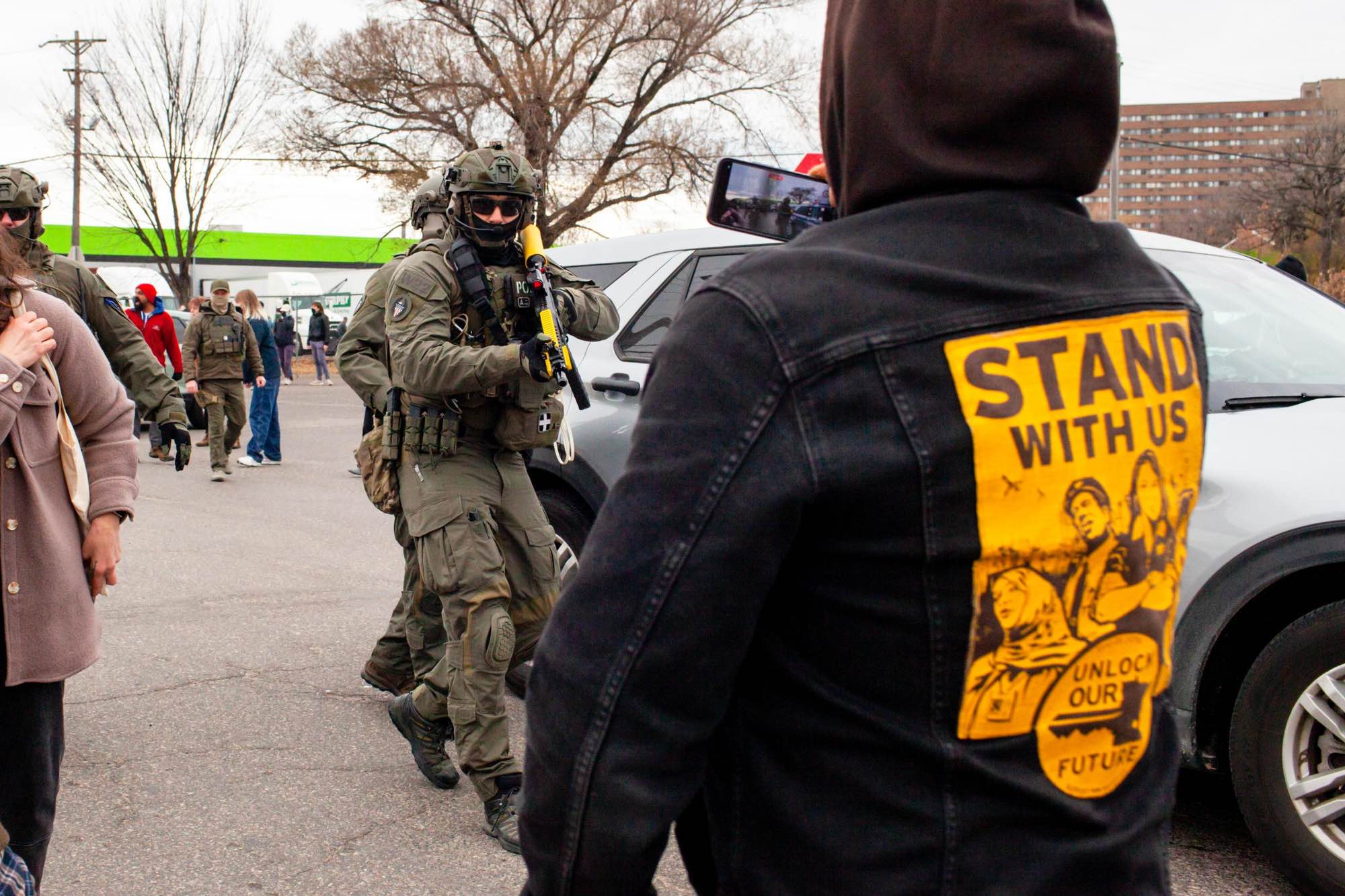
Yesterday, Chile held a historic vote regarding whether to replace the constitution that remains from the dictatorship of mass murderer Augusto Pinochet. Fully 78% of voters called not only to replace the constitution, but to convene an entirely new body of representatives to write the new document rather than permitting current legislators to participate in the process. Although this is widely understood as a popular victory rejecting institutional politics, we also have to understand it as a ploy to draw participants in the estallido social—”social explosion”—that began in Chile one year ago back into the process of representation and legislation, taming the momentum of the movement that forced president Sebastián Piñera to grant the referendum in the first place. In the following account, participants report on the demonstrations observing the one-year anniversary of the uprising of 2019 and celebrating the outcome of the referendum, exploring the possibilities and limitations of the movement as it stands today.

“The people only advance through struggle in the streets.”
A recent two-part article on anarchist news site It’s Going Down analyzed the emergence of the “front line” in United States protest movements. We have seen this phenomenon emerge worldwide, from Hong Kong to Chile, in which demonstrators use an array of tactics to defend their fellow protesters from police violence.
In that article, our friends argue that the front line loses its power when police regain the initiative, determining the terrain in which street conflict can occur and preparing that terrain in order to splinter groups and undercut the movement’s momentum. In both the US and Chile, longstanding revolts are confronting historic elections: yesterday’s Constitutional referendum in Chile and the hotly contested presidential election in the US. The new tactics we’ve learned in street mobilizations will play a crucial role in whatever forms of contestation develop outside these electoral spectacles. We offer reflections on the joys and frustrations that the movement in Chile has experienced over the past two weeks, from the buildup to the one-year anniversary of the October 18 Chilean uprising up to today. We hope to provide insights into the potential pitfalls and possibilities of these tactics, in order to prepare the means to articulate and fight for our vision of a better world in future movements worldwide.
While the anniversary of October 18 celebrated the front line in Plaza Dignidad, the anniversary of “the largest march in Chilean history” was observed with the constitutional referendum of October 25—a concession that Chilean president Sebastián Piñera had offered in hopes of pacifying the movement. Thousands took to Plaza Dignidad to celebrate “apruebo”—a large majority have voted in favor of a new constitutional referendum, throwing out the constitution that remains from the dictatorship of Augusto Pinochet.
The contrasting anniversaries present two distinct celebrations: the new community of revolt that emerged around the burnt metro stations of October 18, 2019 contrasted with the institutional arrangements that aim to supplant the revolt. While the COVID-19 pandemic ended the most visible aspects of the community of revolt, the arrival of spring and the anniversary of the October 2019 uprising allowed for new street mobilizations and combative activity. Encapuchados (masked demonstrators) had regained the initiative and attacked carbinero1 precincts, looted businesses, and pushed police out of Plaza Dignidad for the first time since the COVID-19 pandemic. On the other hand, petty squabbles and fistfights broke out between disparate groups of front liners in the middle of Plaza Dignidad, rupturing the solidarity that has existed since October 2019.

The anniversary of the estallido social.
The practices of the front line have served to resolve longstanding divisions between the disparate political groups—football hooligans supporting opposing teams, anarchists, Mapuche, rotos (self-identified lumpen proletariat), high school students and drop-outs—that fought at the front together. This street combat provided new means of contesting public space: informal street markets, Indigenous land reclamation, peri-urban tomaterrenos, autonomous neighborhood relief initiatives, street art and graffiti. In all of these contexts, heterogeneous forms of participation brought people into the community of revolt, all drawing on different ideals and practices yet together creating an ungovernable force.
The One-Year Anniversary: Day by Day
To understand the movement that offers a counterpoint to electoral politics in Chile, we can’t focus on a single day—we have to look at all the different ways it manifests from one day to the next.

Mapuche march. The banner reads “Assassinated in Democracy,” displaying the faces of some of the victims of Chilean state violence.
Monday October 12, 2020: International Day of Indigenous Resistance
A march of roughly 5000 people began to leave Plaza Dignidad at 11 am, marching towards La Moneda, the presidential palace. As on last year’s day of Indigenous resistance, Mapuche political organizations, labor unions, Aymara marching bands, and dance troupes paraded down the street. But this year, people marched down the main avenue of Santiago, la Alameda, under new banners: the coordinadora victimas de trauma ocular (coordination of eye trauma victims), the coordinadora de 18/Octubre, and other groups that sprang out of this year of revolt. Street vendors and rescatistas (street medic teams) returned downtown to provide the basic necessities for the street mobilization.
Around 1 pm, the march reached the riot police that blocked La Alameda near the presidential palace. Protestors attempted to push past them by throwing rocks and Molotov cocktails before eventually returning to Plaza Dignidad. Molotov cocktails are a rare sight that early in the day, even by Santiago standards. But, as they say, “It’s always 5 o’clock somewhere.” Back at Plaza Dignidad, the agglomeration continued throughout the day.
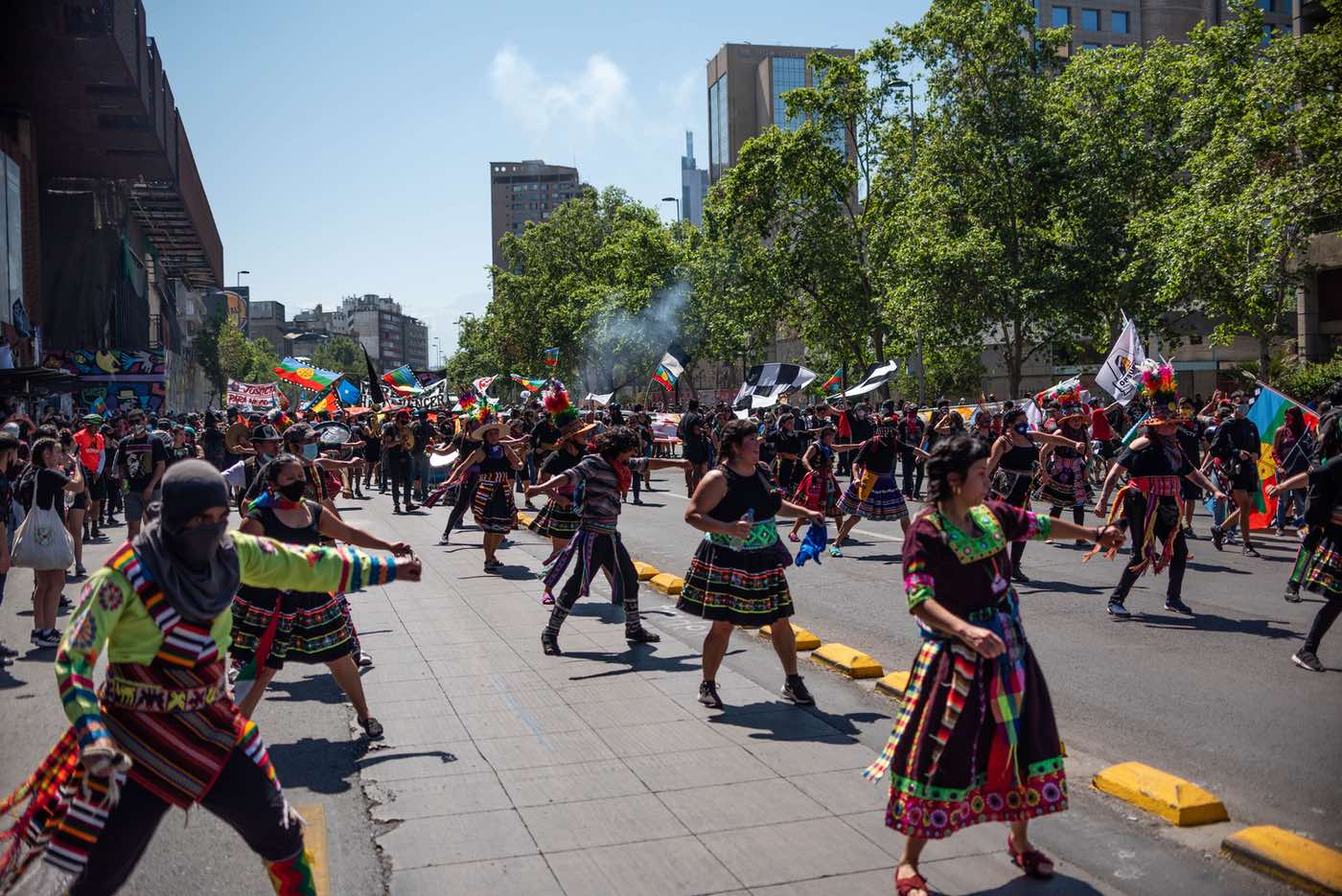
Aymara dancers.

Aymara dancers.
Wednesday, October 14, 2020: Colo Colo Soccer Hooligan Rally; Attack on the Police Precinct in lo Hermida, Penalolen
At 7 pm, Colo Colo fans rallied in Plaza Dignidad, blocking traffic with hundreds of cars. According to a resident nearby, it was unclear why the rally was organized:
“There was a Colo Colo game today against Union Espanola, but Colo Colo didn’t win… I was at home cooking dinner, but then I heard fireworks in the Plaza and decided to go out and see what was happening. People had blocked traffic on both sides with cars and were standing in the Plaza playing music and dancing in the streets. People climbed on top of the Baquedano statue and launched fireworks. After about 30 minutes, the cars drove down the Alameda. People waved flags as they sat in the back of pick-up trucks, on top of their cars, or hanging out of their car windows. Between the cars, people marched and rode bikes, singing and chanting.”
The motorcade continued for several blocks down La Alameda until it arrived at the police barricade downtown. There, people erected burning barricades and battled the police before turning south down Maciver, a narrow one-way street. The march and motorcade continued for miles; some cars began to disperse; the rest arrived in Barrio Franklin, south downtown.
In Penalolen, a Southeastern comuna of Santiago, a small crowd of protestors attacked the local carabinero precinct with rocks and Molotov cocktails. A few days earlier, an undercover agent had been outed as an infiltrator in the neighborhood’s ollas comunes (community kitchens). The police arrested ten youths they claimed to be members of el anti-yuta 21 (the 21 anti-cops), which they claim is an organized group dedicated to attacking police in the neighborhood… and participating in ollas communes.
Santiago’s periphery has developed tactics to evade police and establish favorable terrain for resisting surveillance and control. These localized movements have been occurring simultaneously yet away from the movement in Plaza Dignidad. As we argued in our previous article, ollas comunes in the periphery demonstrate these strategies in part by refusing to seek the government’s authorization to distribute food. It appears that the police share this analysis and fear the unchecked power of self-organization, judging by their decision to send undercover agents to infiltrate ollas comunes. They went so far as to give this particular infiltrator the identity of a real person: a 21-year-old resident of Santiago whose ID they had taken from him while detaining him months prior.2

Fighting a guanaco, an armored water cannon, during the Mapuche march.
Friday, October 16, 2020: The Full Rhythm and Ritual of Plaza Dignidad
Over the past weeks, we have seen more and more people return to Plaza Dignidad each Friday. This Friday’s march was the largest since the COVID-19 pandemic arrived. What was unique was the absence of police: barricades dotted every intersection of Vicuna Mackenna (the central road running north-south through Santiago) and La Alameda. Although sporadic clashes between police and front liners occurred at the southern- and easternmost parts of the street mobilization, police were unable to push protestors out until 9 pm. At that time, a wall of guanacos (armored cars equipped with water cannons), zorrillos (trucks for dispensing tear gas), and police trucks pushed the crowd east and north with tear gas and jets of water.

The Mapuche march.
Saturday October 17, 2020 : Apruebo Feminist Bike Ride and the Opening of the Museo del Estallido
At 11 am, a crowd of 1000 cyclists left from Parque Almagro in south Santiago. After they reached Plaza Dignidad, many continued east along the river while others stayed in the nearby Parque Forestal to enjoy the beautiful spring day.
Later in the day, the Museo del Estallido Social (museum of the social explosion) held its grand opening. Thanks to donations from participants in the movement, the museum has collected a large collection of recorded testimonies of police brutality, physical memorabilia, photography, and print media from the past year. From their website:
“This Museum… is a self-managed platform that arises from the need to document testimonies and events of the Social Explosion that have taken place in Chile since October 18, 2019. The rhizomatic nature of the social rebellion translates into the absence of leadership and spokespeople. The explosion is considered legitimate because it is organic and without mediation. First, because of the broad participation within the social explosion. Second, because the breadth of demands within the explosion respond to an unsustainable discontent around the political and economic model that has prevailed since the Dictatorship, protected by a spurious Constitution.”

A Mapuche performer. The text reads “No More Sacrifice Zones.”
Sunday October 18, 2020: The Big Day
“I woke up at 10:30 am to the sound of cacerolazos, just like during the start of the estallido last year. I looked out of my window and saw a small crowd marching down the street, banging pots and pans, and heading towards Plaza Dignidad. I ran to the kitchen for a wooden spoon and pot so I could join in from my bedroom window before heading to the plaza myself.”
–Emilia, eyewitness
Starting in the morning, marches left from multiple neighborhoods throughout Santiago to end up in downtown. Crews of youth had come prepared with spray paint and wheat paste to decorate every blank building they passed.

New posters appeared on the one-year anniversary of the uprising.
The Limits of the Front Line
During most mobilizations, the conflict between front liners and the police is no more than a few blocks away from the plaza. Days before the anniversary, the police had announced that they would mobilize 40,000 police throughout the country. While we must assume that there were plainclothes police officers concealed in the mobilization, for most of the day, no uniformed riot police came within a kilometer of the plaza. Without street conflicts occurring in tandem with the festivities in Plaza Dignidad, most front liners remained in the plaza with the crowd.
The lack of police presence enabled groups to safely self-organize other activities, such as a punk show was held under a monument south of Plaza Dignidad. However, at roughly 4 pm, a fight broke out between football hooligans of opposing teams—Colo Colo and Universidad de Chile—in the space between the punk show and the plaza. It was unclear how this fight started. Some claimed that people who didn’t like the music threw rocks at the punks, which escalated into a fight between the opposing teams that were caught in the crossfire. Others said it started as a fight between the hooligans to take control of the Baquedano statue because each crew wanted a photo-op on top the iconic monument with their team’s flags. Regardless of how it started, people fled the plaza for the duration of the fight, dodging flying rocks and roman candles.

Participants in the primera linea breaking up the concrete during the Mapuche march.
This brawl between front liners erupting in the middle of Plaza Dignidad suggests a major limit to the format of the front line: without a front line, there are no front liners. People often only erect barricades when police are nearby, rather than pre-emptively creating a favorable terrain for street mobilizations. The standard practice of the front line here is to react to police incursions rather than seizing the initiative.
The power of the front line is that it is rooted in shared practices that anyone can participate in, regardless of political ideology and social differences. Yet neither self- identification nor outside recognition as “being a front liner” can substitute for the shared experiences that tie these disparate groups together. Without the police attempting to empty the plaza, this cohesion eroded as groups fought each other over symbolic spaces and the ability to dictate how the march would be represented.
One way that front liners might be able to overcome this would be if street mobilizations could seize the initiative, experimenting with new tactics at the periphery of the main mobilization. Then, even if the police are not immediately present, front liners could transform the terrain in ways that the police would have to respond to. Instead of emerging only in response to police actions, the front line could carve out larger spaces in the city, revealing new ways for people to participate in the movement irrespective of political and social difference.
“I ran into a friend in Plaza Dignidad who told me a nearby gas station was being looted. We decided to go check it out. While nothing was really left, we grabbed a bunch of packaged sandwiches and fancy fruit juices to share with our friends at the plaza. Five minutes later, police arrived at the gas station and fights broke out between the crowd and the police. Soaking wet from the guanacos, we headed back to the plaza, where we saw people yelling and throwing rocks. ‘Oh no! are police trying to disperse the plaza?’ No, it turned out that people where throwing rocks at each other and people were fleeing the middle. Realizing that I was in the middle of the two opposing groups, I moved quickly to dodge the rocks and get to a safe distance.”
-Anonymous eyewitness
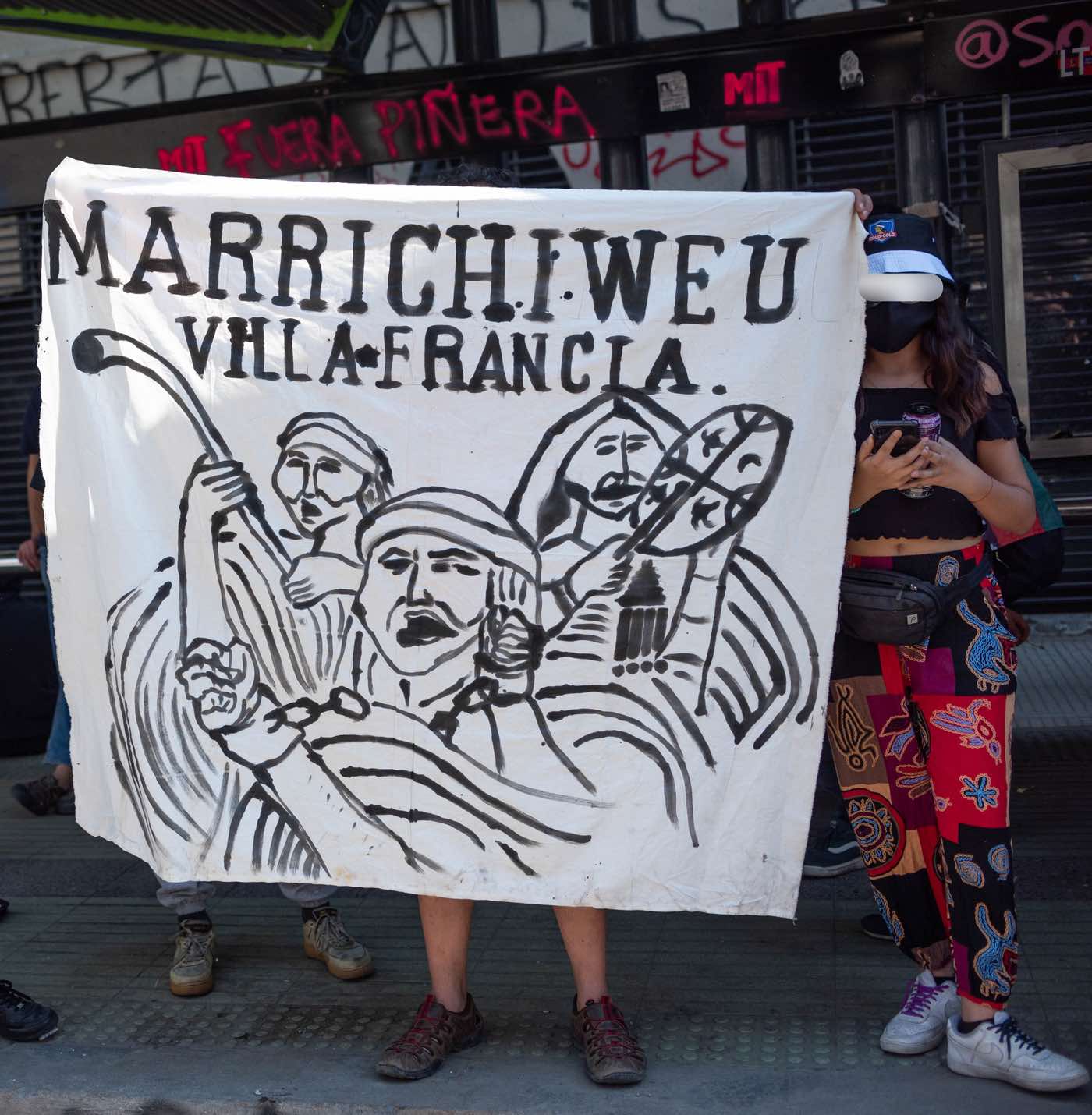
“Marrichiweu” is Mapuche for “Ten times we will win.” Villa Francia is a rebel neighborhood.
The Return of Looting
At the same time that the fight broke out between soccer hooligans, people were looting the stores surrounding Plaza Dignidad. The largest of these businesses included a COPEC gas station, a Santa Isabel supermarket, and the Crowne Plaza hotel. While police arrested the first looters at Santa Isabel, they were unable to defend the supermarket. When the police left, crowds formed around the supermarket; it was cleared out over the course of the day. Two 19th century churches were also looted and burnt to the ground: the Parroquia de La Asuncion, a 19th century church that doubled as a dictatorship-era torture center, and Iglesia San Francisco de Borja, the official church of the carabinero national police.
We often forget that looting is an act of festivity, the importance of which exceeds the physical act of stealing. In the Crown Plaza hotel, whole families and people of all ages walked into the building just to see what the inside looked like, enjoying the adrenaline rush of trespassing. Friends texted each other to announce when a building was being looted so people could obtain some free goods or join the new street protest that assembled outside. On a sunny Sunday afternoon, the return of looting added the sense that the plaza was once again an ungovernable space that provided for all the participants.
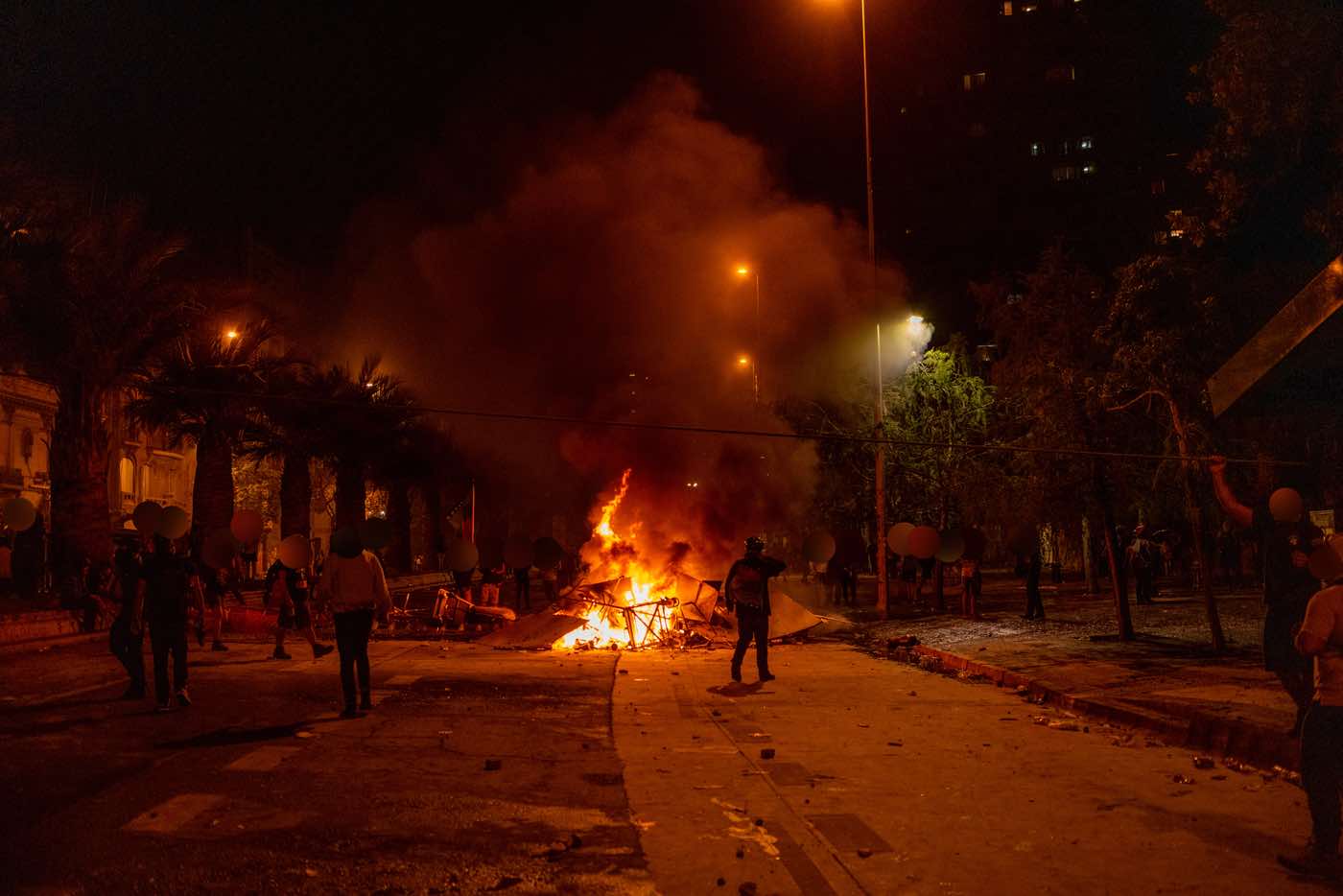
The looted ice cream cooler on fire.
People looted basic necessities independent of their economic value. The Crown Plaza Hotel was looted for furniture to bring out to the barricades. At the Santa Isabel grocery store, encapuchadxs pushed out an entire ice cream freezer to distribute to the crowd. After the fridge was empty, they pushed it into the flaming barricade. The COPEC gas station had little more to offer than alcohol and junk food. Nonetheless, people carried out potato chips and beer, which circulated among the protesters in Plaza Dignidad. It was noteworthy that basic necessities were the first to clear the shelves: diapers, baby formula, produce, and meat. The electronics there could be sold online for money that could buy much larger quantities of these products than what people could carry, people focused on the basic necessities that have been beyond their reach during the ongoing economic crisis.3
The police and institutional left seek to create distinctions between “criminal” and “law-abiding” protests. While looting was understood as an appropriate blow against the physical institutions of political power in Chile, attacking churches was controversial because they appear to be outside of the existing social conflict. Rumors abound. Were the attackers protestors or just delinquent youth? La primera linea or anarchists? Many on the right went so far as to claim that they were secret agents sent by the Venezuelan Government. Many leftists claimed it was a montaje—police infiltrators carrying out violent actions to make protestors look violent and therefore illegitimate. Yet, as others have argued), property destruction against abusive institutions actually increases support for nascent movements and underscores the illegitimacy of political regimes.
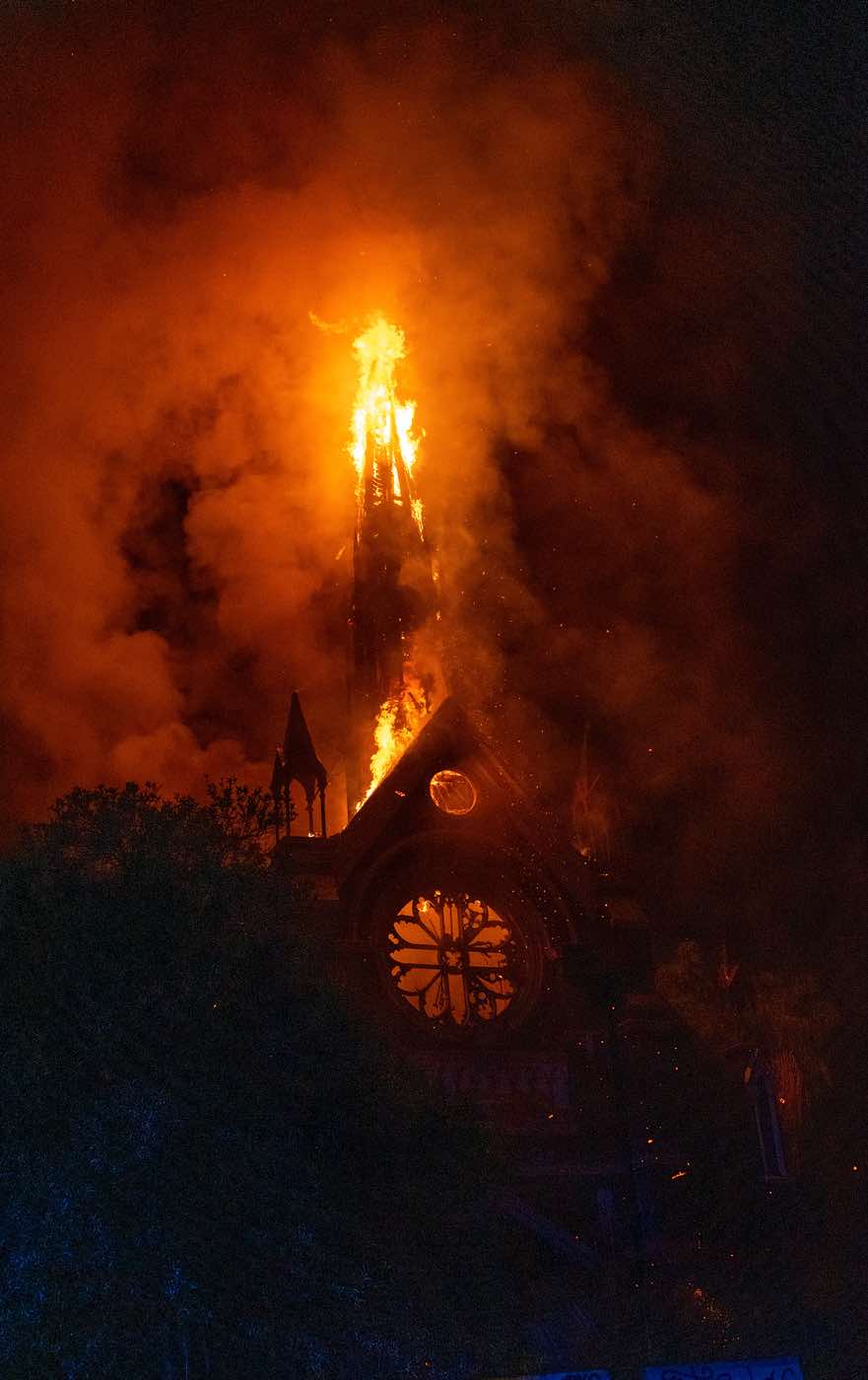
The burning of the church at which the sins of the police are absolved.
Refusing to add fuel to the rumors, many on the left have instead sought to explain the attacks on the two churches. For example, the official church of the carabineros, located directly behind a large monument to the carabineros, was given to the national police force during the Pinochet dictatorship. Ever since the dictatorship, the Chilean police and military have had their own parallel, separate institutions including everything from hospitals to government pension systems, and the Chilean Catholic Church is no different. The San Francisco de Borja church holds special services specifically for carabineros and their families. Since the estallido, police have used this church as a staging ground for their crowd dispersal operations, erecting a wall of concrete barricades around the church and memorial complex. The decision to make the church a part of the policing makes it a target for ire in the context of widespread unrest.
However, we find it insufficient to adopt the terms of debate set by critics or the police. This is what occurs when we try to refute unsubstantiated rumors by justifying property destruction after the fact. Police and outside observers constantly attempt to distinguish between the “criminal” and “law-abiding” elements of street demonstrations. This maneuver is intended to make parts of the crowd understand themselves as “law-abiding” and therefore legitimate, in order that they will distance themselves from the actions occurring throughout the street mobilization. For anyone on the side of the revolt, it is self-evident why churches used by police and military could become targets for a crowd’s rage. In attempting to justify the actions that the police condemn, we risk retaining the framework of “good” protester versus “bad” protestor.
Instead of seeking to justify the property destruction in a broader street mobilization according to a framework of political protest, we can instead appraise the importance of a particular action by illuminating the ethics demonstrated by the crowd. The police and other critics of the revolt hope to establish an association between governability and community well-being. Instead, we can point out the ways that the people in ungovernable situations act to preserve their collective well-being while becoming uncontrollable together.

Firefighters attempting to extinguish the church of the carabineros.
While the churches were looted, people cheered as pews and statues were added to the barricades. When ambulances and firetrucks arrived, protestors rushed to clear a path and then quickly put the obstacles back in the road. When the church caught fire, people chanted “Que se queme!” (“Let it burn!”). Despite the crowd’s support of the action, protestors saved the most important part of the church: a doghouse in the garden beside it for neighborhood street dogs. When encapuchadxs were about to put the doghouse in the fire, other protestors yelled: “No la casita, es para los perros del barrio” (“Not the doghouse! It’s for the neighborhood street dogs.”). The encapuchadxs carried the doghouse all the way back to the garden, returning it to its original location. While in street protests, it is often common for protestors to stop encapuchadxs from destroying property, there did not seem to be anyone in the crowd concerned about stopping people from setting the church on fire.
While the media covered and condemned the acts of violence against the two churches, very few media outlets discussed the police brutality in Santiago’s periphery. At the same time that the churches were burning, carabineros in the La Victoria neighborhood killed someone at a protest. Shortly after the murder, 300 encapuchadxs attacked a police precinct in Puente Alto with rocks and Molotov cocktails, injuring one officer.

A banner supporting political prisoners. It reads “Solidarity with Monica and Francisco—no innocents, no guilty!”
The October 25 Referendum
It is ironic that the date of the referendum was the anniversary of what is famously “the biggest march in Chilean history,” a march involving a significant proportion of the entire population of Chile. The contrast between embodied presence and alienated representation could not be starker. Over the course of the next two years, a mixed convention of congresspeople and elected delegates will compose a new Chilean constitution. Few are convinced this constitutional referendum will lead to the transformations they want to see.
The referendum involved two questions. First: do you approve or reject a new constitution? Second: should the new constitution, if approved, be written in a mixed convention, comprised of delegates from the current legislature as well as delegates picked by a later popular vote? Despite the parties in the streets celebrating the prospect of a new constitution, we remember that this referendum arose out of an agreement between the political elites in November 2019, involving both the conservative government its opposition in the institutional left. Leftist political parties fractured because their constituencies did not want to negotiate with the government, demanding instead that the Piñera government should be jailed for human rights violations.
In a recent CrimethInc. article, “Between Electoral Politics and Civil War,” our friends argue that electoral politics is based on the same logic as civil war. Although the US far right represents civil war as an alternative to electoral politics, in reality, both electoral politics and civil war lead to a consolidation of majoritarian positions as diverse practices and visions are forcibly subsumed in larger positions. Neither of these positions leads to greater freedom.
While it appears that the US is on the brink of civil war, Chile appears to be on the brink of electoralist cooptation. The October 25th referendum is the first of eight elections that will be held in Chile between 2020 and 2022. The left acknowledges that the referendum is rigged against substantial change, so we must continue to struggle. Despite the referendum not representing their vision, they argued that we had a responsibility to vote for it, because it could be the only opportunity to get rid of Pinochet’s constitution of 1981.
The mythos and debates surrounding this referendum serve to blind us to the totalizing logic of electoral politics. As at the end of the Pinochet era, elections and referendums serve to channel energy out of the diverse forms of revolts across the country. Critics may denounce the arrangement of each particular election, while nonetheless insisting that electoral politics is more important than the new practices and visions of the community of revolt.
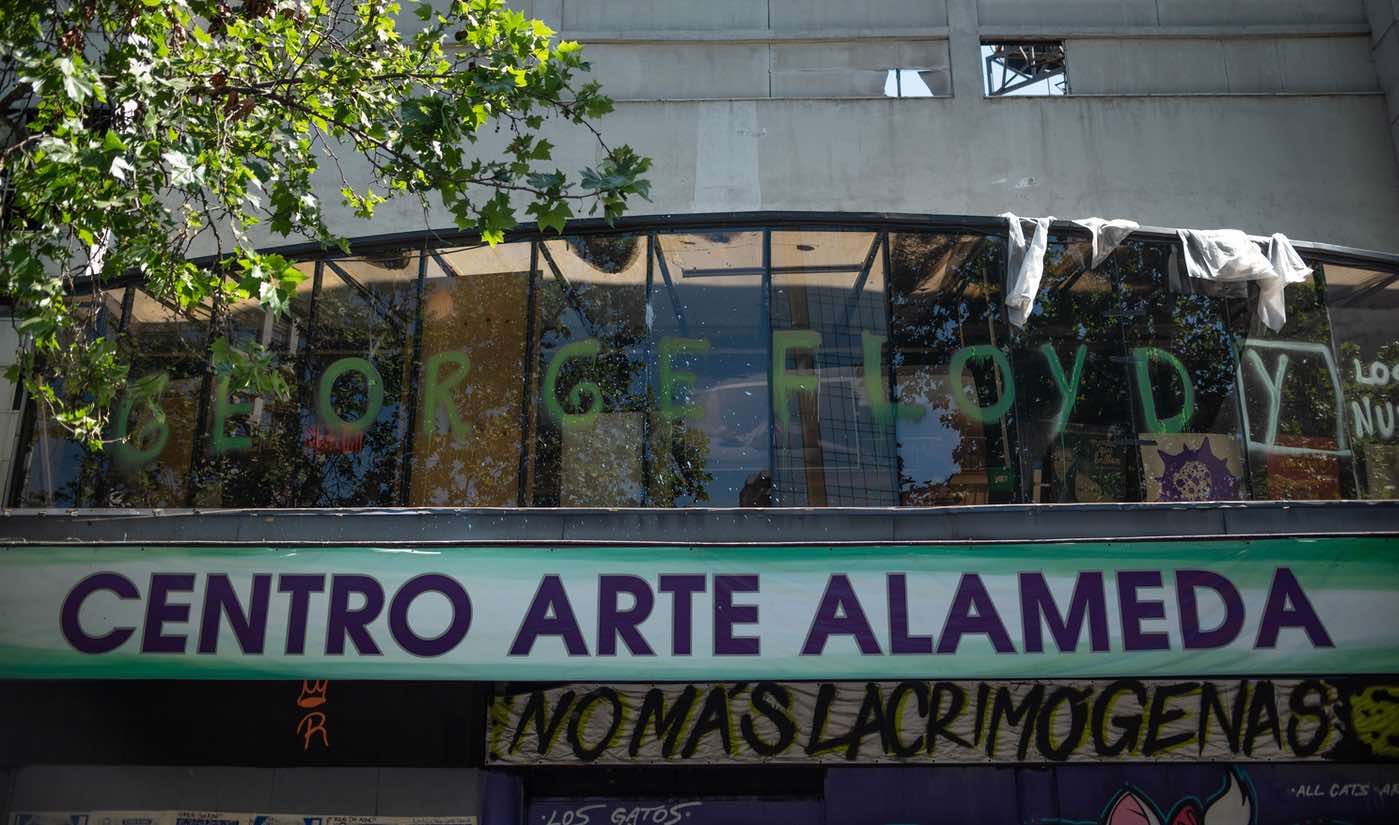
Graffiti along the main thoroughfare in Santiago memorializing George Floyd.
Now, more than ever, a political practice focused around this or that particular election is bound to prove insufficient. Rather than contesting the electoral system according to the politics of representation, we can instead identify the ways that electoral politics impacts our movements. When elections take place, marches and street demonstrations are banned and it is standard procedure for the military to police public space. Ahead of the 2017 election, the military evicted several feminist high school occupations so that those institutions could be used as polling stations. The military’s return to the streets dramatically escalated last year’s revolt, yet exceptional forms of social control go uncontested when the government implements them as part of the electoral process. The current election cycle presents a new narrative shaping our relation time, in which everyone feels that change could be achieved by means of the election right around the corner—we just have to wait and see. More and more election days means more and more electoral movements that can provide incessant opportunities for self-proclaimed “community leaders” to emerge as the voice of the majoritarian, homogenous movement they desire. Meanwhile, these electoral procedures serve as opportunities to tighten control on our lived territories.
This is a moment in which practices and visions must proliferate that point a way beyond the choice between electoral politics and civil war. We find it inspiring that the night of the apruebo victory marked the first time people took the streets and stayed out past the military curfew. Despite the ban on alcohol, liquor ran in the streets. There were no police in sight; the ruins of the police church were open for all to enter and enjoy. Ironically, the election presented an opportunity for revolt, despite the pretenses of a peaceful, constituent process. We must find ways to offer those currently not involved in the revolt a new way of participating. Ways that people can engage in the same practices—whether that means fighting on the front line, seizing vacant land for a neighborhood, or playing music in the streets—that allow them to develop their own analysis of why and how to do it.
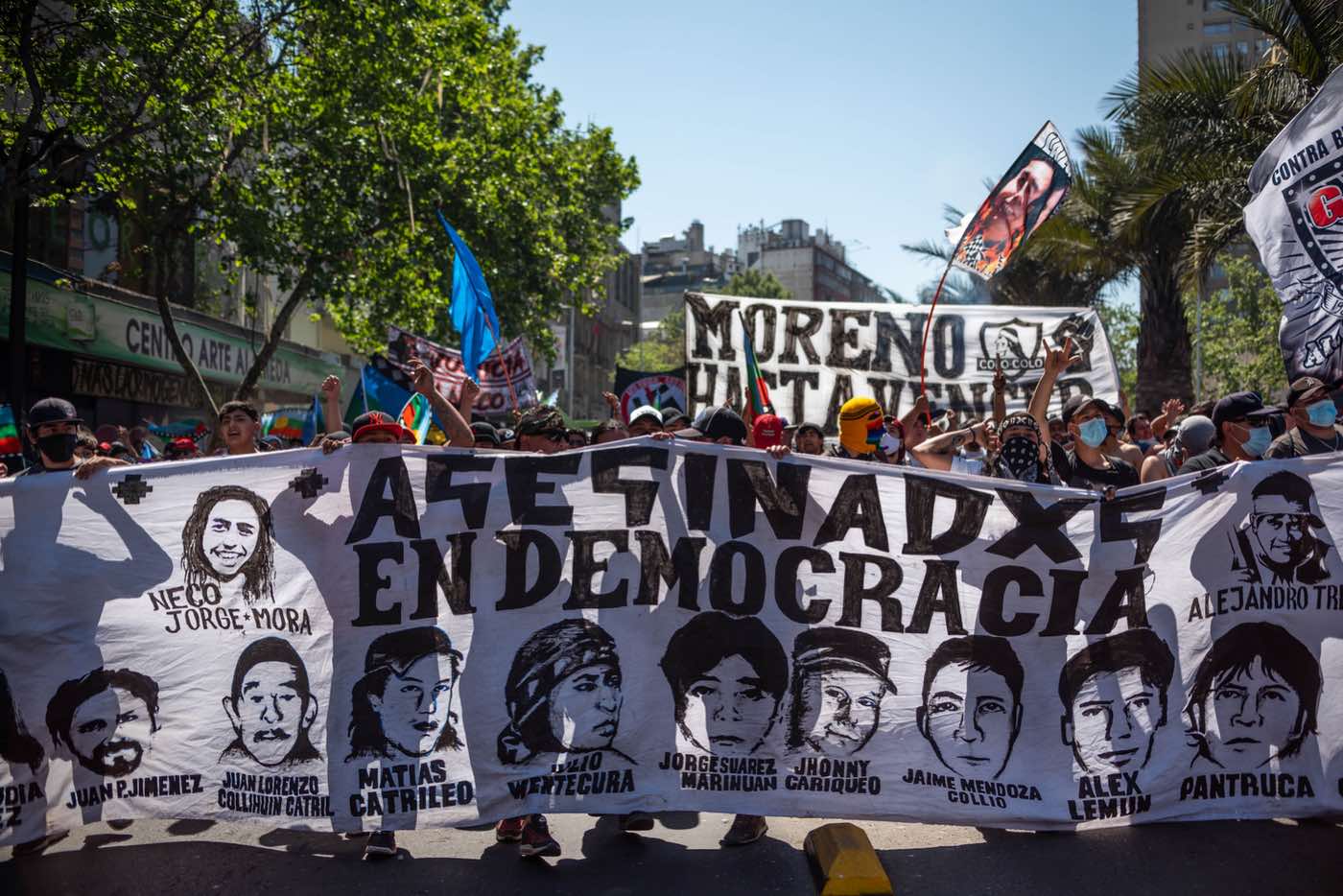
For those murdered in democracy.
-
Carabineros are Chilean military officers with law enforcement duties targeting the civilian population, similar to Spain’s guardia civil and France’s gendarmerie. In contrast to the US, there are no local police under local municipal authority. The carabineros report to the Ministry of Interior and Ministry of Defense. ↩
-
That’s right—like sorcerers, the police can steal your identity and turn it into a ghost to stalk your peers. ↩
-
The economic crisis has shuttered most businesses; only the grocery stores and “essential stores” remain open with consistently stocked shelves. Yet, the institutions that were looted are known for making life miserable for millions of Chileans. Santa Isabel and Lider are owned by Lidl and Walmart respectively. They dominate the market of basic necessities, yet they charge significantly more than the street markets, importing many of their goods from abroad. The “best value” generic brands that stock the shelves of Lider and Walmart are considered “premium” brands here in Chile. Many of these businesses have been found guilty of price-fixing basic necessities, elevating the price of toilet paper, chicken, and medication. ↩


